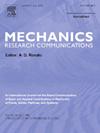具有应力驱动非局部弹性和任意边界条件的Bishop纳米棒
IF 2.3
4区 工程技术
Q3 MECHANICS
引用次数: 0
摘要
一维结构元件,如粗杆,在纳米级机电系统的发展中是必不可少的。它们在小尺度上的设计和力学行为可以使用非局部连续介质力学有效地描述,与原子方法相比,它可以捕获尺寸依赖效应和远程相互作用,同时降低计算成本。本文采用Bishop模型,结合非局部积分本构关系,对具有实际边界条件的小尺度粗杆进行了分析。通常,非局部关系是由Eringen的积分模型推导出来的,其中一点的非局部应力通过fredholm型卷积积分依赖于整个应变场。然而,当应用于有界域时,这种应变驱动的公式可能导致不一致。为了解决这些问题,采用了应力驱动的非局部积分公式,提供了一个允许解析解的适定力学模型。对不同边界条件下非局部效应的影响进行了参数化研究。理论和数值结果有助于更好地理解纳米棒的力学行为,并为小型部件的设计提供有价值的见解。本文章由计算机程序翻译,如有差异,请以英文原文为准。
Bishop nanorods with stress-driven nonlocal elasticity and arbitrary boundary conditions
One-dimensional structural elements, such as thick rods, are essential in the development of nanoscale electromechanical systems. Their design and mechanical behavior at small scales can be effectively described using nonlocal continuum mechanics, which captures size-dependent effects and long-range interactions while reducing computational costs compared to atomistic methods. This study analyzes small-scale thick rods with realistic boundary conditions using Bishop’s model, incorporating a nonlocal integral constitutive relation. Usually, the nonlocal relation is derived from Eringen’s integral model, in which the nonlocal stress at a point depends on the entire strain field through a Fredholm-type convolution integral. However, this strain-driven formulation may lead to inconsistencies when applied to bounded domains. To address these issues, a stress-driven nonlocal integral formulation is adopted, providing a well-posed mechanical model that admits analytical solutions. A parametric study is conducted to evaluate the influence of nonlocal effects under various boundary conditions. Theoretical and numerical results contribute to a better understanding of the mechanical behavior of nanorods and offer valuable insights for the design of small-scale components.
求助全文
通过发布文献求助,成功后即可免费获取论文全文。
去求助
来源期刊
CiteScore
4.10
自引率
4.20%
发文量
114
审稿时长
9 months
期刊介绍:
Mechanics Research Communications publishes, as rapidly as possible, peer-reviewed manuscripts of high standards but restricted length. It aims to provide:
• a fast means of communication
• an exchange of ideas among workers in mechanics
• an effective method of bringing new results quickly to the public
• an informal vehicle for the discussion
• of ideas that may still be in the formative stages
The field of Mechanics will be understood to encompass the behavior of continua, fluids, solids, particles and their mixtures. Submissions must contain a strong, novel contribution to the field of mechanics, and ideally should be focused on current issues in the field involving theoretical, experimental and/or applied research, preferably within the broad expertise encompassed by the Board of Associate Editors. Deviations from these areas should be discussed in advance with the Editor-in-Chief.

 求助内容:
求助内容: 应助结果提醒方式:
应助结果提醒方式:


